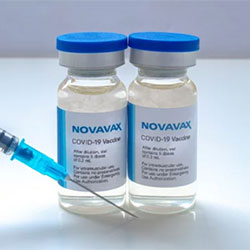By Landon Gray
The effort to overcome remaining vaccination hesitancy was at the forefront of the conversation as the CDC’s Advisory Committee on Immunization Practices (ACIP) unanimously recommended the Novavax COVID-19 vaccine—a recommendation that was promptly endorsed by the CDC.

“Depending on the data source, somewhere between 10.3% and 13.9% of all adults in the U.S. have not received any vaccines,” said Matthew F. Daley, MD, the chair of ACIP’s COVID-19 Vaccines Work Group.
Since the beginning of the COVID-19 pandemic, more than 89 million cases and more than 1 million deaths have been reported in the United States. However, between 26 million and 27 million adults in the United States have yet to be vaccinated against the disease.
The Novavax COVID-19 vaccine, which will be administered as a two-dose series, provides a more familiar vaccine technology that might help overcome the hesitancy of some people, the CDC said. Protein subunit vaccines package harmless proteins of the COVID-19 virus alongside an adjuvant that supports the immune system’s response to the virus. Vaccines using protein subunits have been used for more than 30 years in the United States, beginning with the first licensed hepatitis B vaccine.
“In May 2022, unvaccinated adults ages 18 years or older had a 3.5 times higher risk of COVID-19–associated hospitalization compared with people who completed a primary vaccine series and at least one booster or additional dose,” said Katherine E. Fleming-Dutra, MD, a member of the CDC’s COVID-19 Epidemiology Task Force, who updated the committee on COVID-19 epidemiology and vaccination rates in the United States.
In that same period, data showed unvaccinated people who were 12 years of age and older are nine times more likely to die from COVID-19 compared with vaccinated people who have received a primary series and booster dose.
While vaccination rates are higher in older groups, the rates decrease in correlation with age. Nearly 20% of adults in the United States aged 18 through 24 years, 20% from 25 through 39 years and 13% from 40 to 49 years have yet to receive a COVID-19 vaccine, Dr. Fleming-Dutra said.
Demographic data pertaining to vaccination rates also were shared.
As previous data indicated, COVID-19 has disproportionately affected ethnic and racial minorities, as well as those living in rural areas or who lack access to appropriate healthcare.
So far, 20% of American Indians or Alaska Natives, 14% of Hispanics, 14% of whites and 22% of people of mixed or other races have yet to receive a COVID-19 vaccine, she said.
“We can see that a higher percentage of U.S. adults with incomes less than $75,000 and particularly those living below poverty remain unvaccinated compared with adults with higher incomes,” Dr. Fleming-Dutra said. “And when we look at these data biomarkers of access to healthcare, we see that a higher percentage of U.S. adults who do not have a regular primary care provider remain unvaccinated compared with those who do, and a higher percentage of those who do not have health insurance remain unvaccinated compared with those who have health insurance.”
Concerns about serious adverse events, particularly myocarditis, related to vaccination is another reason for vaccine hesitancy in the United States, the presenters said. Although the risk is rare, there is still a risk.
There have been 1,321 verified reports of myocarditis, affecting more males than females, that met the case definition out of 491.9 million primary series and first messenger RNA (mRNA) COVID-19 boosters administered to adults who are 18 years of age and older in the United States. The median age in the cases of verified myocarditis is 28 years of age, and most presented with symptoms within the first week after receiving a vaccine dose. Most of the events occurred after the second primary dose.
And most of the patients who experienced myocarditis fully recovered.
“At 81.7%, most healthcare providers who completed surveys indicated the patient was fully recovered or probably fully recovered,” said Tom Shimabukuro, MD, MPH, MBA, a member of the CDC’s COVID-19 Vaccine Coordination Unit, who presented on myocarditis after mRNA COVID-19 vaccination. “Most patients who were reached reported no impact on their quality of life, and most did not report missing school or work.”
Rochelle Walensky, MD, MPH, the CDC director, urged anyone who is hesitant about receiving a vaccine to explore the expanded options available. “If you have been waiting for a COVID-19 vaccine built on a different technology than those previously available, now is the time to join the millions of Americans who have been vaccinated. With COVID-19 cases on the rise again across parts of the country, vaccination is critical to help protect against the complications of severe COVID-19 disease,” she said.
“The scientific evidence is clear that the available COVID-19 vaccines are safe and effective in preventing hospitalization, severe illness, and death. We continue to strongly urge everyone who has not yet been vaccinated against COVID-19 and is eligible, including pregnant people, to get vaccinated as soon as possible, and when eligible to get a booster dose, to protect themselves and their loved ones,” said Sandra Adamson Fryhofer, MD, in a statement from the American Medical Association (AMA). Dr. Fryhofer, who is the board chair of the AMA, also serves as the AMA liaison with the ACIP.
{RELATED-HORIZONTAL}